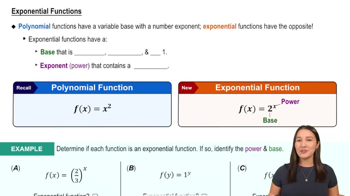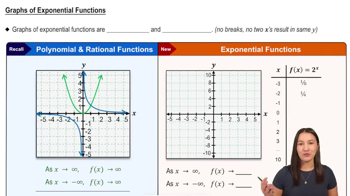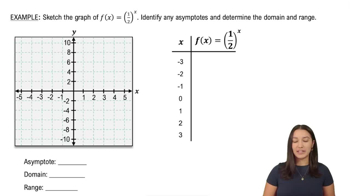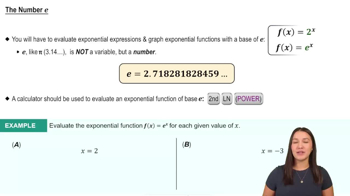Table of contents
- 0. Functions7h 52m
- Introduction to Functions16m
- Piecewise Functions10m
- Properties of Functions9m
- Common Functions1h 8m
- Transformations5m
- Combining Functions27m
- Exponent rules32m
- Exponential Functions28m
- Logarithmic Functions24m
- Properties of Logarithms34m
- Exponential & Logarithmic Equations35m
- Introduction to Trigonometric Functions38m
- Graphs of Trigonometric Functions44m
- Trigonometric Identities47m
- Inverse Trigonometric Functions48m
- 1. Limits and Continuity2h 2m
- 2. Intro to Derivatives1h 33m
- 3. Techniques of Differentiation3h 18m
- 4. Applications of Derivatives2h 38m
- 5. Graphical Applications of Derivatives6h 2m
- 6. Derivatives of Inverse, Exponential, & Logarithmic Functions2h 37m
- 7. Antiderivatives & Indefinite Integrals1h 26m
0. Functions
Exponential Functions
Problem 1.46
Textbook Question
Solve each equation.
7y−3=50
 Verified step by step guidance
Verified step by step guidance1
First, recognize that the equation is in the form of an exponential equation: \( 7^{y-3} = 50 \). Our goal is to solve for \( y \).
To solve for \( y \), take the natural logarithm (ln) of both sides of the equation to bring down the exponent: \( \ln(7^{y-3}) = \ln(50) \).
Apply the logarithmic identity \( \ln(a^b) = b \cdot \ln(a) \) to the left side: \( (y-3) \cdot \ln(7) = \ln(50) \).
Isolate \( y-3 \) by dividing both sides by \( \ln(7) \): \( y-3 = \frac{\ln(50)}{\ln(7)} \).
Finally, solve for \( y \) by adding 3 to both sides: \( y = \frac{\ln(50)}{\ln(7)} + 3 \).
Recommended similar problem, with video answer:
 Verified Solution
Verified SolutionThis video solution was recommended by our tutors as helpful for the problem above
Video duration:
2mPlay a video:
Was this helpful?

 6:13m
6:13mWatch next
Master Exponential Functions with a bite sized video explanation from Callie
Start learning




